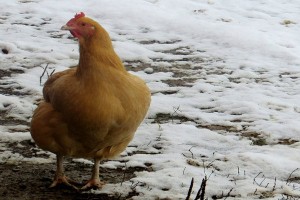Overnight two inches of wet, sloppy snow fell on Southern Ohio. This morning local schools started late; the sound of children screeching with delight bounced off the hills and echoed through the hollows as I cleaned the barn. At least someone was enjoying winter’s debut.
After last winter’s vortex cold and never-ending snow, I am anxious to see what this winter has in store. In years past I trusted The Weather Channel to keep me in the know. Then winter 2013-2014 totally blindsided modern meteorologists, and left me out-cold. After that I looked to other forecasting methods to shed light on the season’s weather.
Winter folklore
Last fall a self-proclaimed “mountain man” came to do some work on our woodstove.
“Bird n’ bees nesting high in the trees tell a harsh winter is on the way…,” he warned, “You’ll be happy to have this woodstove workin’ right!”
At the time I smiled and nodded politely, but when winter walloped just as he predicted, I wondered whether folk wisdom is more accurate than scientific forecasting methods.
Folklore says to expect a severe winter if geese migrate early, pine cones are bigger than normal, acorn shells are thick and squirrels gather them early. A clerk at Kroger added this winter wisdom to my list, “When leaves fall early winter will be mild. When leaves fall late winter will be severe.”
Last week the evening news assessed whether the brown band on woolly worms can accurately predict winter’s intensity. Folklore tells a thin brown band means a long, severe winter. The news was quick to give a disclaimer: there is no scientific backing to folk forecasting. But I’ve observed many folk methods are spot-on and many science-based methods are hit and miss.
Your best bet may be to pick up a farmers’ almanac or two
There are two farmers’ almanac versions on store shelves: The Old Farmer’s Almanac (1792) and The Farmers’ Almanac (1818). Both rely on secret equations that take astronomy, history and meteorology into account to make their long-range weather predictions. Both also share entertaining folk wisdom about the weather.
How accurate are the almanacs?
I called my sister in the upper Midwest last week to tell her both almanacs predicted a heavy snowstorm was headed her way. She awoke the next morning to several inches of snow and her children screaming “Santa is coming!” The almanacs also accurately predicted the first snowfall in southern Ohio this week, along with much colder temperatures.
The almanacs mutually claim over 80% accuracy weather forecasting. They agree this winter will be biting cold. The Old Farmer’s Almanac predicts higher than average snowfall for the Northeast and parts of the Midwest, while The Farmers’ Almanac predicts higher than average snowfall in the Northeast, but average snowfall for parts of the Midwest. Either way it appears we are in for another harsh winter, so “Enjoy the sunshine while it lasts: piles of snow and blustery blasts!” (The Old Farmer’s Almanac 2015).














Did I miss something? When and where did the 2 inches of snow fall in Southern Ohio?? I’m in northern Lawrence Co Ohio (can’t get much farther south) and all we’ve seen is a couple flakes on Monday. I think I could have counted all of them on one hand. I did see several cars in Jackson with a couple inches of snow on them, but figured they were from “up north”.
…whatever.
It IS what it IS. Got to remember this is O-H-I-O folks, not Florida!
As we speak, I am up on our roof fixing shingles in 55+MPH gusts with a 60*F temp.
Got to think this is still Autumn!
Y’all have a Blessed Thanksgiving Day!